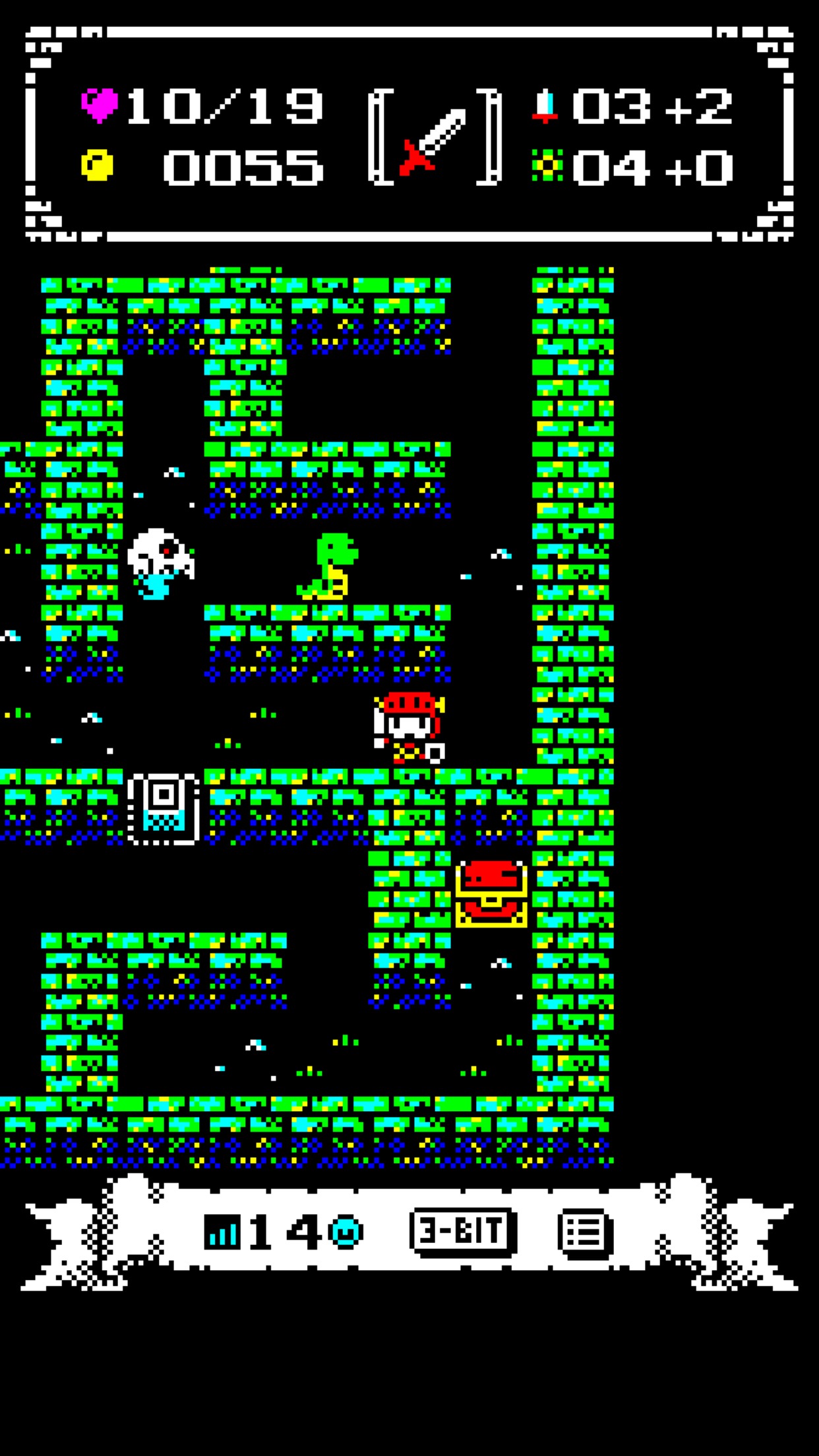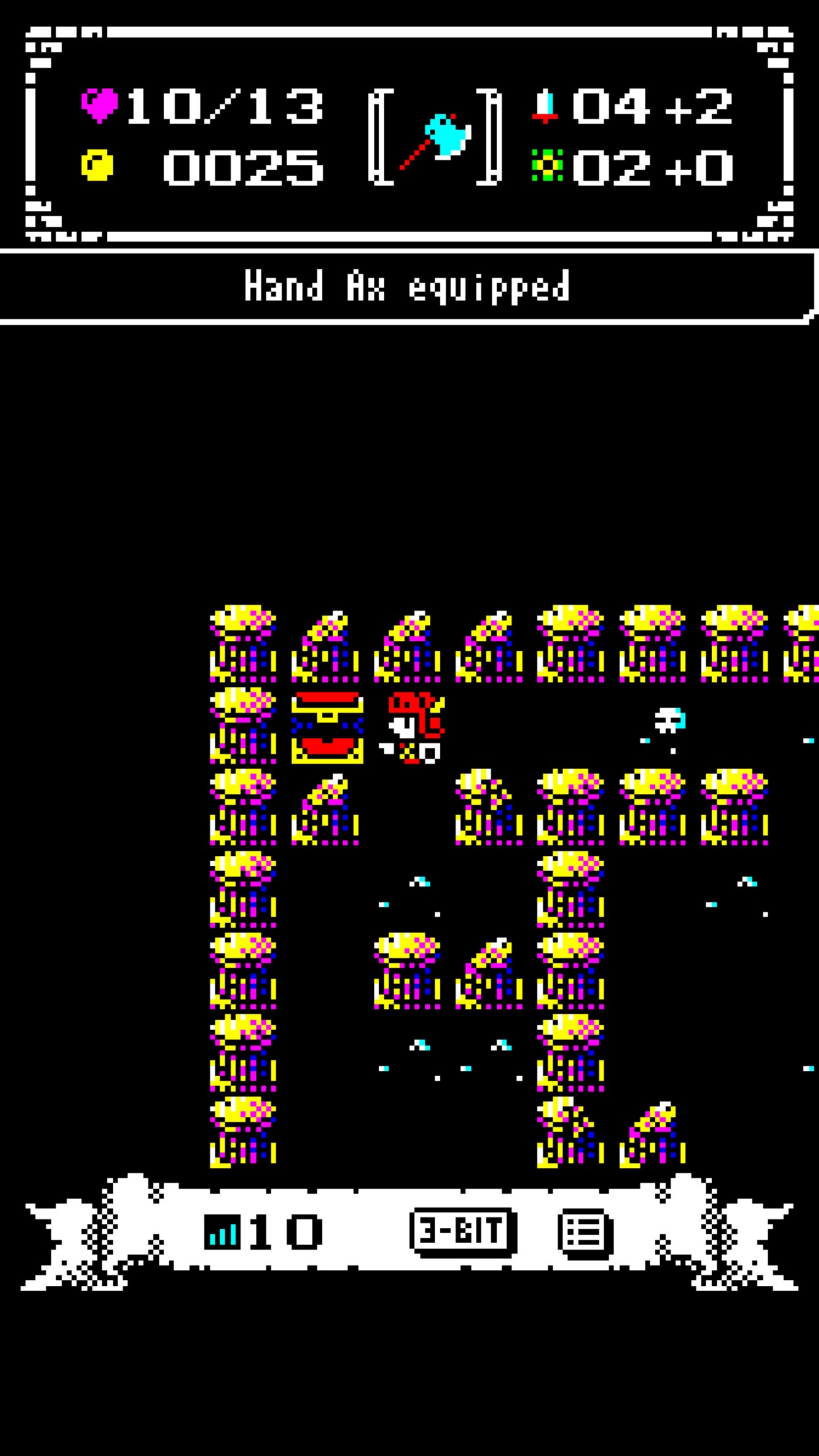 Okay, we’re at a point now where it’s highly unlikely many mobile gamers are itching for another roguelite. It’s proven to be a popular genre on mobile, which means everyone, their uncle, and their uncle’s cat has released some kind of variation on the time-honored theme. 1-Bit Rogue (Free), from Kan Kikuchi and popular Japanese indie developer Skipmore, is the latest to give it the old college try, and while it’s a pretty fun game, I’m not sure it has much to say to anyone looking for something to perk up the genre. It does all the things well that Skipmore usually excels at: the retro-style presentation feels authentic, there are fun unlockables, and it’s an easy game to come to grips with. If nothing else, that makes it worth checking out for a game or three.
Okay, we’re at a point now where it’s highly unlikely many mobile gamers are itching for another roguelite. It’s proven to be a popular genre on mobile, which means everyone, their uncle, and their uncle’s cat has released some kind of variation on the time-honored theme. 1-Bit Rogue (Free), from Kan Kikuchi and popular Japanese indie developer Skipmore, is the latest to give it the old college try, and while it’s a pretty fun game, I’m not sure it has much to say to anyone looking for something to perk up the genre. It does all the things well that Skipmore usually excels at: the retro-style presentation feels authentic, there are fun unlockables, and it’s an easy game to come to grips with. If nothing else, that makes it worth checking out for a game or three.
 As the title implies, 1-Bit Rogue is a simplified version of a roguelike. But more than that, it’s a simplified version of a Japanese-style roguelike, a sub-genre some might argue is already in a more streamlined form. Games like Shiren the Wanderer found a way to boil down the often highly-complex rules of a genre that mostly existed on home computers, and make it palatable for the simpler control inputs and technical capabilities of consoles.
As the title implies, 1-Bit Rogue is a simplified version of a roguelike. But more than that, it’s a simplified version of a Japanese-style roguelike, a sub-genre some might argue is already in a more streamlined form. Games like Shiren the Wanderer found a way to boil down the often highly-complex rules of a genre that mostly existed on home computers, and make it palatable for the simpler control inputs and technical capabilities of consoles.
The end result has a great deal in common with PC roguelikes, but is different enough that a person could conceivably like one and not the other. Both varieties pride themselves on extreme difficulty and making the most of your luck, good or bad. The main way they differ is that in Western roguelikes, you don’t typically carry anything over from attempt to attempt save your own increased knowledge. With enough studying and a bit of luck, you could conceivably win quite a few Western roguelikes on your first attempt.
That’s not the case for Japanese roguelikes, which often place an emphasis on preparation for the one perfect run. The Shiren games allow you to stow items in a storehouse where you can retrieve them on subsequent runs. You can refine a weapon over the course of several runs, building up to the point where you will finally be powerful enough to score a victory. Again, with a little luck. It’s that idea, the notion of powering up over the course of multiple runs, that sits at the core of 1-Bit Rogue. You start off with one character unlocked, the warrior. As you play through the game, you’ll gather coins, which can be used in that run for a variety of purposes, or carried forward to spend on things like stat upgrades and new characters after your run is finished. You’d have to have a tremendous run of luck to get very far with your default character, but as you build up their HP, you’ll be able to reach new depths and eventually beat the game.
 The gameplay itself is as simple as it could be. On each floor, you need to find the stairs to the next level of the dungeon. That requires you to first hit a switch located somewhere in the level that will reveal those stairs. There are monsters patrolling the hallways who don’t seem to like you very much, statues that can grant you boons or curses, chests that contain one of any number of useful goodies, and traps that will probably kill you if you trip them. What makes this simpler in structure than the average Japanese-style roguelike comes down to a few things.
The gameplay itself is as simple as it could be. On each floor, you need to find the stairs to the next level of the dungeon. That requires you to first hit a switch located somewhere in the level that will reveal those stairs. There are monsters patrolling the hallways who don’t seem to like you very much, statues that can grant you boons or curses, chests that contain one of any number of useful goodies, and traps that will probably kill you if you trip them. What makes this simpler in structure than the average Japanese-style roguelike comes down to a few things.
First, the maps are quite small. They start off almost fitting completely on one screen, and while they get a little bigger as they go, you’ll never need a map or anything like that to keep track of things. Second, there are always going to be a set number of each type of object per stage, depending on depth. For example, one treasure chest and two monsters. Third, you can only carry one item at a time. Any found medicine will be drank on the spot, any weapons you pick up will replace the current one, and anything your character can’t use will be turned into cash.
Defeating enemies will add to your maximum HP most of the time, so it’s important to do some killing now and then. You’ll have to balance your blood thirst against how easily your weapons break, however. Weapons are only good for a set number of kills before they break, and since you can only carry one at a time, that leaves you quite vulnerable until such time as you can find another one in a chest somewhere. This can lead to some hairy situations, particularly if the only chest on a level holds medicine instead of a weapon. You can still fight back without a weapon, but if you’re more than a few levels in, the chances are quite good that your opponent will be dealing more damage per turn to you than you are to him. You’ll have to make tough choices about whether you want to seek out fights to make sure you’re strong enough to survive the fights that seek you out, or saving your weapon to make sure that when those fights come, you aren’t left barehanded.
 There are lots of different enemy types, each with their own stats and behaviors. Since your character’s abilities don’t really change that much through the course of each playthrough, this variety of opponents helps keep the game fresh. In addition to adding to your maximum HP total, beating enemies will also reward you with varying amounts of coins. Within a playthrough, you can use those coins to pray at the altars and statues you might come across, or for a one-time continue should you die. There are two gods you can pray to. The first will give you blessings that are only beneficial, while the other will give you a curse that might benefit you in one way and hurt you in another. You’ll want to make good use of these options, but you’ll also need to save up those coins, because after your run is completed, you can use them to level up your character’s HP permanently.
There are lots of different enemy types, each with their own stats and behaviors. Since your character’s abilities don’t really change that much through the course of each playthrough, this variety of opponents helps keep the game fresh. In addition to adding to your maximum HP total, beating enemies will also reward you with varying amounts of coins. Within a playthrough, you can use those coins to pray at the altars and statues you might come across, or for a one-time continue should you die. There are two gods you can pray to. The first will give you blessings that are only beneficial, while the other will give you a curse that might benefit you in one way and hurt you in another. You’ll want to make good use of these options, but you’ll also need to save up those coins, because after your run is completed, you can use them to level up your character’s HP permanently.
You’ll also need an awful lot of those coins if you want to unlock the four additional characters. The prices on the last couple of characters are particularly steep, but the coins add up faster than you might expect. There’s no way to buy them with real money, so your only option is to grind them out. The game’s sole IAP simply adds a 3-bit color mode and strips out the ads that otherwise appear quite frequently in both banner and pop-up forms. Once you’ve purchased that IAP, the only ads remaining in the game are the incentivized ones you can choose to watch for a continue in lieu of paying the gold penalty. Similar to when you pay for a continue using coins, you can only continue once by this method, so everyone is on the same playing field.
In terms of the presentation, 1-Bit Rogue isn’t far off from other Skipmore efforts such as Fairune (Free) and Drancia (Free). One key difference is that the game is, by default, only displayed in black and white. If you buy the 3-bit mode IAP, you’ll have access to an optional color mode that adds a few splashes of color to things. Fortunately, both modes are clear and detailed enough to support the gameplay. I found I preferred the 3-bit mode a bit, but either choice will give you a charmingly faux-retro vibe. The music follows a similar route, and if you like chiptunes, you’ll probably enjoy what’s coming out of the speakers here.
1-Bit Rogue is a fun little pick-up-and-play title, but given the embarrassment of riches in the roguelite genre on iOS, it doesn’t really stand out in any significant way. The controls can be a little fussy, and getting your character in shape for a proper run at the final boss involves a fair chunk of grinding. I’d also advise strongly against sticking with the free version for very long, because it really leans hard on the advertisements. Still, the presentation is attractive and the game on the whole is competent if not terribly exciting. It’s hard to get too thrilled for an average roguelite these days, though, and that’s basically all that 1-Bit Rogue is.